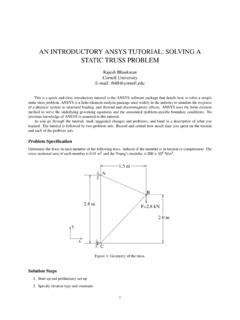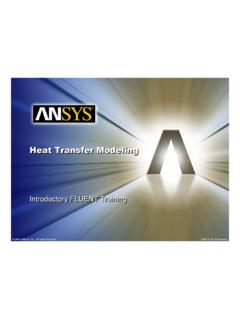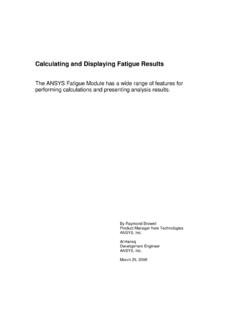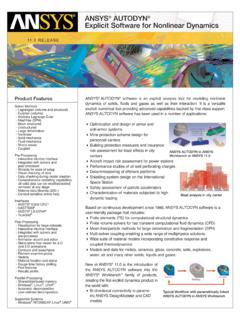Transcription of Vertical Probe Mechanical & Thermal-electrical ...
1 Vertical Probe Mechanical & Thermal-electrical characterization using Finite Element AnalysisYan ChenSV TCL An SV Probe CompanyOverview Objective Modeling Approach: SPM vs. ALM ALM Convergence TrioTMProbe Model BCF Deflection Stress Profile Scrub Thermal-electrical Behavior Other Vertical Probe Models: SmartTouchTM Conclusion2 Yan ChenObjective Speedy Vertical Probe characterization with validated FEA Probe models BCF Validation DOE Size Reduction Performance evaluation of Vertical probes at extreme testing conditions CCC under high temperature & high current3 Yan ChenModeling Approach4 Yan Probe Model(SPM)Assembly Level Model(ALM) Single Probe Model (SPM) Probe only geometry Artificial boundary conditions Linear system with short runtime Higher stiffness than the experimental setup Assembly Level Model (ALM)
2 Probe & components in contact with the Probe Frictional contact conditions Highly non-linear system with long runtime & difficult to converge Matching stiffness to the experimental setup with fine tuned contact conditionsProbe OnlyProbeUGPLGPST PadALM Convergence 5 Yan ChenNon-linear contact models with gaps often face convergence issues, which require fine tuning of the contact conditions for the most accurate output. At times, some compromises in contact conditions are necessary to achieve convergence. Major parameters to be adjusted in contact conditions include: Mesh Density (especially in contact regions) Coefficient of Friction (u) Contact Interface Treatment Normal Stiffness Factor (n)Gaps between Probe &guide plates allow rigid body motion in Convergence: Contact Interface6 Yan ChenCertain contact interface treatment or gap treatment in FEA codes allow establishment of contacts prior to loading, to prevent rigid body motion; or leave gap as is.
3 It is crucial to choose the correct or the most appropriate gap treatment at different contact surfaces. Contact SurfaceTarget SurfaceContact SurfaceTarget SurfaceRigid Offset MeshContactInterface TreatmentReference: ANSYS Inc. "Introduction to Contact." Web. Rigid Body MotionALM Convergence: Normal Stiffness7 Yan Chen Normal stiffness in contact: When two separate surfaces touch each other & become mutually tangent, they are considered in contact Surfaces in contact should not interpenetrate & be able to transmit compressive normal forces & tangential friction forces FEA solvers often use normal stiffness in penalty based contact formulations to enforce contact compatibility Lower normal stiffness factor relieves convergence issues due to high contact force, but it causes more penetrationIdeally, xpenetrationshould be zero and knormalshould be infinite, which is numerically Stiffness & PenetrationReference: ANSYS Inc.
4 "Introduction to Contact." Web. Trio Probe Model: BCF8 Yan ChenThe above-mentioned modeling approach is applied to SV TCL s Trio Probe (a Cobra-style Probe ). The experimental BCF results are plotted with the SPM & ALM BCF data for the mil Probe as below. BCF (gf) Error (%) +86% +36% Results on mil Trio Trio Probe Model: BCF (cont.)9 Yan ChenWith proper contact conditions, the Trio Probe ALM can accurately predict BCF to +9% on the mil Probe . As shown, contact 2 & contact 3 models have similar BCF results. Depending on the purpose of a study, either contact 2 or contact 3 model can be selected, contact 2 is more accurate for LGP stress ALM-contact2 ALM-contact3 Coefficient of FrictionabbNormal Stiffness FactorxxxUGP Contact ttsLGP ContacttstBCF (gf) (%)+36%+10%+9%Experimental BCF = gfBCF Results on mil Trio Trio Probe Model: Deflection10 Yan ChenProbe deflection profiles can help visualize Probe interactions under various configurations.
5 For Trio probes , the deflection mode is predetermined by the direction of the stamped ribbon regardless of the contact conditions. On other Vertical probes , the deflection mode is highly dependent on contact conditions between the Probe & the guide plates. The deflection profile is necessary for BCF matching & contact tuning. Example of mil Trio Probe Deflection ProfilesTrio Probe Model: Stress Profile11 Yan ChenStress profiles on the Probe & the guide plates indicate the Probe overdrive tolerance & frictional effects between the Probe & guide plates. Stress on mil Trio ProbeStress on mil Trio LGPS tress on mil Trio UGPTrio Probe Model: Scrub12 Yan ChenScrub Length on mil Trio Probe in LGP before OverdriveProbe in LGP after OverdriveLeaning EdgeLeaning EdgeThe mil Trio model predicts a scrub length of m ( m *2), close to an experimental measurement of 5 m scrub on a glass surface.
6 Trio Probe Model: thermal -electrical13 Yan ChenFor high temperature and high current applications, the following heat equation governs the temperature change on the probes . The ALM Trio model can be modified for Thermal-electrical studies to better capture all the heat terms in the equation. This ALM variation assists to evaluate the current carrying capability (CCC) of Trio probes under ISMI-CCC standard. Conductive HeatingConvection Heat LossFinal Temperature ChangeRadiation Heat LossJoule HeatingReference:Wang, Xuan, Natnael Behabtu, Colin C. Young, Dmitri E. Tsentalovich, Matteo Pasquali, and Junichiro Kono. "High-Ampacity Power Cables of Tightly-Packed and Aligned Carbon Nanotubes." Advanced Functional Materials (2014): 3241-249. ALMTrio Probe Model: Thermal-electrical (cont.)
7 14 Yan ChenIn the example here, Joule heating & conductive heating effects are observed on the probes as the temperature rises due to the flowing current. The temperature profiles on the probes can be obtained for all chuck temperature & current combinations, which then become the inputs to the Mechanical SPM or ALM model for evaluation of BCF drop/residual curves. Temperature on 2 mil Trio Probe (average current = 500 mA at 25 C)Trio Probe Model: Thermal-electrical (cont.)15 Yan ChenWith an assumed plastic model for the Probe material (bilinear hardening), the ALM Thermal-electrical model yields more conservative CCC values than the experiment. The accuracy can be improved with a material model based on temperature dependent strain-stress curves (multilinear hardening).
8 Reference: ANSYS Inc. Nonlinear Structural Analysis" Web. Simulated BCF Residual on 2 mil TrioTMExperimental BCF Residual on 2 mil TrioTMBilinear HardeningMultilinear HardeningSmartTouch Probe Model16 Yan ChenThe ALM approach is not limited to the Trio Probe . It is applicable to any Vertical probes . Below are the BCF correlation results on SV TCL s SmartTouch Probe (straight Probe ). The simulated BCF is accurate to + of the experimental results on SmartTouch BCF results on SmartTouch SmartTouch Probe Model (cont.)17 Yan ChenFor the SmartTouch Probe model, deflection profiles are necessary to identify correct contact conditions. The effects of contact conditions on SmartTouch deflection is demonstrated in the example below. ALM-contact1 ALM-contact3 Coefficient of FrictionabNormal Stiffness FactorxxGP1 Contact ttGP2 ContacttsGP3 ContacttsSame material propertiesSame geometrySame loadingsONLY contact changesDeflection modes under different contact conditionsALM-contact1 ALM-contact3 VARIABLESRun# var1var2var31axu2axv3ayu4ayv5bxu6bxv7byu 8byv9cxu10cxv11cyu12cyvParametric Study on SmartTouch 18 Yan ChenA parametric study on the SmartTouch Probe model before a design optimization reduced the DOE size by half, as it showed extreme high stress within the system on certain configurations.
9 Those runs were eliminated from the actual DOE. The study indicated Run#8 to be the optimal configuration. The final DOE results lined up closely with the parametric study. Reduced DOE on SmartTouch Conclusion ALM models are more accurate than SPM models in terms of characterizing BCF, deflection profile, stress profile & scrub Thermal-electrical studies require geometric modifications for better thermal boundary condition match ALM models require longer computational time, which can be challenging for large size parametric studies Whenever possible, preliminary studies can be performed on SPM to reduce the size of the study before a full-fledged ALM parametric study19 Yan ChenFuture Work In-depth scrub studies of scrub length & depth on different pad materials Develop an ALM Probe model for MEMS Probe characterization Incorporate more accurate plastic Probe material models for the thermal -electric study Incorporate fatigue Probe material models to study effects of pulsed current loadings in the thermal -electric study20 Yan ChenReferences ANSYS Inc.
10 "Introduction to Contact." Web. ANSYS Inc. Nonlinear Structural Analysis." Web. Wang, Xuan, NatnaelBehabtu, Colin C. Young, Dmitri E. Tsentalovich, Matteo Pasquali, and Junichiro Kono. "High-Ampacity Power Cables of Tightly-Packed and Aligned Carbon Nanotubes." Advanced Functional Materials (2014): 3241-249. ChenAcknowledgementsSpecial thanks to Pankaj Ahirwar, Kyle Cotner, Merlin Dudley, JB Hollstein, Jeff Hicklin, Mohamed Hegazy, Pete Rogan, Robert Stampahar & Jordan Wahl in the SV TCL team, for their effort & support in this ChenQuestions?







